Navigating Washington, DC with Metro
Find out everything you need to know to ride dc’s world-class metrorail system, get a metro map, check operating hours, ride fares and more..
Washington, DC’s Metro is one of the busiest public transportation systems in the country. Its expansive network of tunnels and above ground tracks connect all four quadrants of DC with suburban Virginia and Maryland. The system is heavily used by local commuters and it’s a popular, convenient and affordable way for visitors to DC to get around the region, now so more than ever. Metro has opened its new Silver Line extension, which allows riders to connect to Dulles International Airport and explore Loudoun County. Visit Metro's website for more information about the extension.
Find information about the Washington, DC Metro system:
DC Metro Map
- How Metro Works & Metro Trip Planner
- Metro Fares
- Metro Hours
- Metro Etiquette
Please download the touch-free SmarTrip app for iPhone and Android .
A Metrorail system map will help you navigate the nation's capital during your trip. Click the Washington, DC Metro map below to view a larger version.
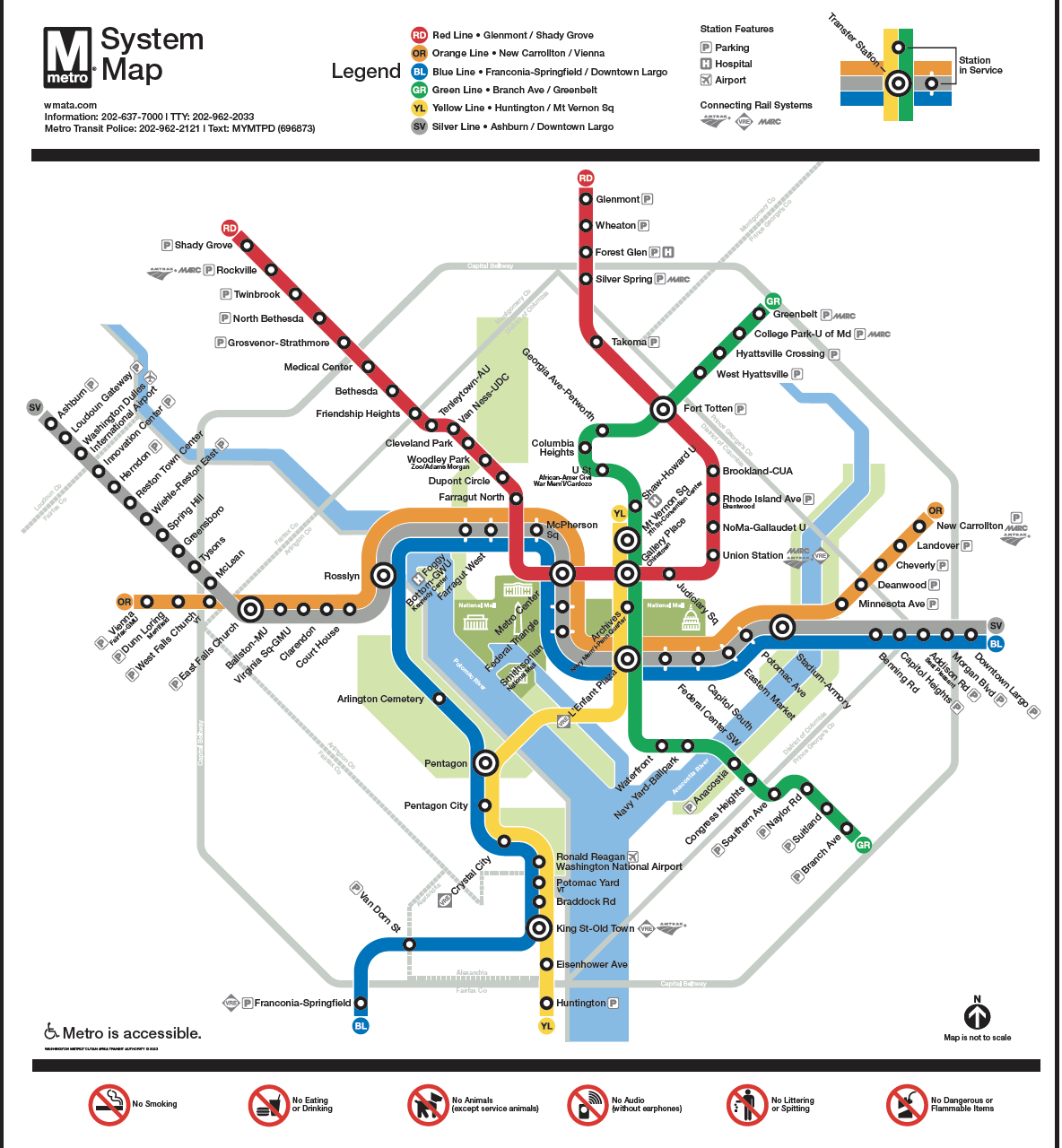
How does the Washington, DC Metro work? How do I plan my trip?
The Metro consists of six color-coded lines: Red, Blue, Orange, Yellow, Green and Silver. The lines are connected to each other via transfer stations and many Metro stops are serviced by more than one color. Each train car has an exterior electronic sign that marks the color and the direction of the train. Direction is indicated by the final station of that line.
Popular sightseeing Metro stops include the Smithsonian (Orange, Silver and Blue lines), Woodley Park-Zoo/Adams Morgan (Red line) and Gallery Place-Chinatown (Red, Green and Yellow lines). You can plan your trip and find the best route using Metro's Trip Planner .
Worried about internet connectivity while traveling on Metro? Currently, most Metro stations have free Wi-Fi .
How much are Metro fares and how do you use SmarTrip?
Metro fares are calculated by how many stops you travel and vary during peak and off-peak hours. During peak hours, most fares range from $2.25 to $6 per trip. During off-peak hours, fares typically range from $1.85 to $3.85.
Metro riders must pay via SmarTrip card or the SmarTrip app on iPhone and Apple Watch . SmarTrip cards are plastic, rechargeable fare cards that can be purchased by cash or credit at any Metro station or in advance on wmata.com . You can calculate your fare between two stops using Metro’s Trip Planner .
The SmarTrip app can be used anywhere the SmarTrip card is accepted, including rail, buses and Metro-operated parking lots. Metro is the first rail system in the U.S. to offer a full-service, touch-free payment option at every single stop. See below for more information about how to use SmarTrip in your Apple Wallet .
What are the Metro's hours and when does it close?
DC Metro trains run Monday - Thursday, 5 a.m. until 12 a.m.; Friday, 5 a.m. until 1 a.m.; Saturday: 7 a.m. until 1 a.m.; Sunday: 7 a.m. until 12 a.m.
Metro etiquette
The Washington, DC Metro serves thousands of commuters and visitors each day. Because the train system is so heavily used by busy local commuters, there are a number of unspoken rules that visitors should be aware of. If possible, you may want to ride at off-peak hours when the train system is much less hectic.
When riding the escalator, stand to your right, walk to your left. Standing in a twosome that blocks the left side is strongly (and often loudly) discouraged by your fellow Metro riders.
When waiting to board a train, let riders exit the train first before trying to board. If the train is particularly crowded and you are standing in a doorway, step just outside the train doorway to allow your fellow riders room to exit.
Another important note if the train is crowded: move to the middle of the car so others can board. You will have time to exit when you arrive at your stop.
During peak hours, trains arrive often. Don’t try to board a train that is too full. The automatic doors are very sensitive and if they can’t close, the train operator may offload the entire train because a door stopped working.
Each car usually has several seats for handicapped riders. Please don’t use these seats if there is a rider that needs to sit down.
Be sure and have your SmarTrip card out and ready to swipe when you go through the gate. Riders move through quickly and holding up the line is discouraged.
While the Metro can be a very busy place, most of your fellow riders are friendly and will point you in the right direction. There is also a station manager at each station. Don’t be afraid to ask if you have questions about navigating the Metro!
Now that you have read up on the Metrorail experience, learn about other ways to navigate DC. Check out the best transportation options for getting around the District.
More About DC

You may also like..
Guide to Union Station in Washington, DC
Getting to Washington, DC
Washington, DC Safety Information
Using the Washington, D.C. Metro Subway System
Hours, Fares, Rules, and More
:max_bytes(150000):strip_icc():format(webp)/Rachel-58092b055f9b58564c6639af.jpg)
Tim Santimore / Getty Images
The Washington Metro, the District's regional subway system, provides a clean, safe, and reliable way to get around almost all of the major attractions in Washington, D.C. The Metro also extends to the suburbs of Maryland and Virginia.
Although the trains can be crowded with commuters during rush hour and when there is a big event downtown, taking the Washington Metro is usually cheaper and easier than finding a place to park in the city. Several Metro stations are helpful sightseeing stops.
The Metro Lines
Since opening in 1976, the Washington Metro (previously, the Metrorail) network has grown to include six lines, 91 stations, and 117 miles of track. It is the second busiest rapid transit system in the United States in the number of passenger trips after New York City. It is administered by the Washington Metropolitan Area Transit Authority (WMATA).
The Metro lines intersect so that passengers can change trains and travel anywhere on the system. A seventh line is proposed, the Purple Line, with service to Maryland, which is expected for completion by 2022.
- Red : Glenmont to Shady Grove
- Orange : New Carrollton to Vienna/Fairfax-GMU
- Blue : Franconia-Springfield to Largo Town Center
- Green : Branch Avenue to Greenbelt
- Yellow : Huntington to Greenbelt
- Silver : Wiehle-Reston East to Largo Town Center
The Metro begins operation at 5 a.m. on weekdays, 7 a.m. on Saturdays, and 8 a.m. on Sundays. Service ends at 11:30 p.m. Monday through Thursday, 1 a.m. Friday and Saturday, and 11 p.m. on Sundays, although the last trains leave the terminals about 30 minutes before these listed times.
Trains frequently run, averaging four to 10 minutes between trains with frequency increasing during rush hour times. Night and weekend service varies between eight and 20 minutes, with trains generally scheduled every 20 minutes.
Metro Farecards
A SmarTrip card is required to ride the Metro. The rechargeable, proximity card is encoded with any amount up to $300. If you register your card, and you lose it, or it is stolen, you do not lose the value of the card.
Fares range from $2 to $6, depending on your destination and the time of day. Fares are cheaper after 9:30 a.m. until 3 p.m. and after 7 p.m. until close. An all-day Metro pass is available for $13.00. The Metro charges reduced fares on all federal holidays.
Discounted fares are available for school children, handicapped passengers , and the elderly. Up to two children, age four and under, ride free with each adult paying full fare. Children 5 and older pay adult fares.
The fare is automatically deducted from your card when you exit the gates. You can keep reusing the same card and add money to it at the SmarTrip vending machine.
You may add value to a SmarTrip card from the convenience of a computer. To use the online reload feature, you must have a registered SmarTrip card and an online account. To complete the transaction, you must touch your SmarTrip card to a Metrorail fare gate, vending machine, or bus farebox. The same card can be used to pay for Metrobus fare.
Employers may provide free transportation as a fringe benefit to their employees. Employers can assign transit benefits directly to their employees' SmarTrip card.
Parking at Metro Lots
Metro operates parking facilities at 44 stations. You can use your SmarTrip card to pay for parking at the Metro Stations. Major credit cards are accepted at most parking facilities.
The cost of parking at a Metro parking lot ranges from $1.00 short-term parking (per hour) to $5.20 for the day during the week. On weekends and holidays, parking is free (except during special events). Reserved monthly parking permits are available for $45 to $65 at all stations, and this fee is paid in addition to the regular daily parking rate.
No eating or drinking is allowed on the Metro. As a courtesy, handicap seating must be available for the disabled or elderly. To assist with the flow of passengers, allow people to get off the train before you board.
- The most crowded times are 7:45 a.m. to 8:45 a.m. and 4:45 p.m. to 5:45 p.m.
- The busiest days are Tuesdays, Wednesdays, and Thursdays.
- If you have flexibility in your schedule, consider riding Metro during the reduced fare hours: after 9:30 a.m., before 3 p.m., and after 7 p.m. on weekdays.
- Save time by keeping enough fare on your card so that you do not have to add money at the vending machine each time you ride.
- Keep your money and valuables out of sight.
Metro Security
Safety call boxes (dial "0") are located at the end of each rail car and every 800 feet along the tracks if you need to report an emergency. Always be aware of your surroundings. For your security, Metro Transit police officers are at the stations and on trains and buses.
Travel Guide to Visiting Washington, D.C. on a Budget
Getting Around Seattle: Guide to Public Transportation
Getting Around Paris: Guide to Public Transportation
National Cherry Blossom Festival Transportation Guide
Guide to Public Transportation in Washington, D.C.
How to Travel From Dulles Airport to Washington, DC, by Train, Bus, and Car
Getting Around Mexico City: Guide to Public Transportation
Getting Around Sao Paulo: Guide to Public Transportation
Getting Around Taipei: Guide to Public Transportation
Getting Around Melbourne: A Guide to Public Transportation
Getting Around Shanghai: Guide to Public Transportation
Navigating the METRO Blue Line in Minneapolis
Getting Around Montreal: Guide to Public Transportation
Getting Around Kolkata: Guide to Public Transportation
Getting Around Los Angeles: Guide to Public Transportation
Getting Around Budapest: Guide to Public Transportation
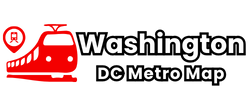
DC Metro Map, Navigating Washington, DC with Metro
Washington DC’s metro system is the economical and convenient way of transportation for both locals and tourists to move around the nation’s capital, including Maryland and Virginia. If you are a visitor and want to get an overview of different metro stations and nearby tourist attractions such as the US Capitol Building, Washington Monument, National Mall, White House, etc., then you need an interactive metro map.
Here’s the updated version of the DC metro map. With this map, you can easily navigate around the city, plan your trips, and reach your final destination without getting lost. Let’s take a deep dive into the high-resolution Washington metro map with streets and explore its different routes and stations.
DC Metro Map, Click to Enlarge
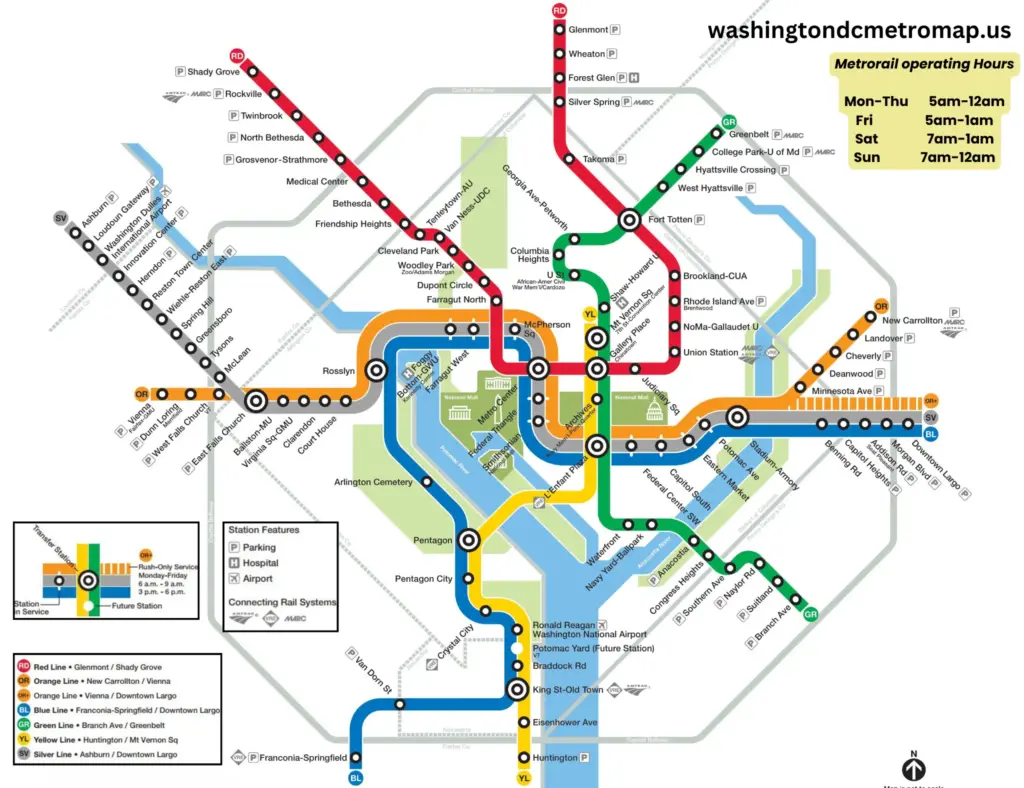
Washington DC Metro Routes
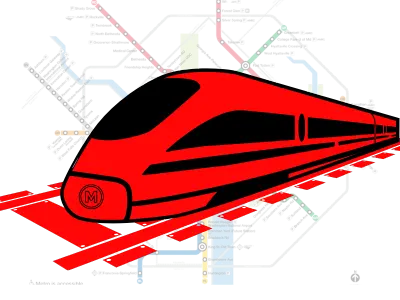
How Does the DC Metro Map Work?
The DC metro is the busiest transportation network, with over 355,000 weekday entries recorded by 2023, according to WMATA . The metro network consists of six color-coded lines: Orange Line, Red Line, Silver Line, Blue Line, Green Line, and Yellow Line. There are a total of 98 stations indicated by small circles on the map, and 128 miles of track. Potomac Yard is the most recent station added to the metro network on May 19, 2023. Many stations are accessible by more than one line sharing track with each other. For example, if you are planning a visit to the White House, then the closest station to it is the Federal Triangle, accessible by three lines. The following table shows different lines sharing tracks between different stations.
Different metro lines are connected with the help of transfer stations(that allow you to change from one route to another), indicated by a double circle on the map. The metro network consists of 8 transfer stations. For example, to travel from Capital South station to the Zoo, you would need to take the silver, orange, or blue line to Metro Center station. From there, transfer to the red line and continue to the Zoo. Here’s the list of different transfer points:
- Fort Totten (Red, Green and Yellow)
- Metro Center (Red, Orange, Silver, and Blue)
- Rosslyn (Orange, Silver and Blue)
- East Falls Chruch (Silver and Orange)
- L’Enfant Plaza (Yellow, Green, Blue, Silver and Orange)
- Stadium-Armory (Orange, Silver and Blue)
- Pentagon (Yellow and Blue)
- King St-Old Town (Yellow and Blue)
While reading the map, the line on the top of the other lines shows it is physically on the top floor. For example, at the Metro Center station, the red line is upstairs and the blue, silver, and orange lines are downstairs. WATMA metro trip planner is the most convenient way to plan your trip around the capital. The other transit networks are easily accessible by Metrorail, including Dulles International Airport, Ronald Reagan Washington National Airport, Baltimore Washington International Airport, and train services like MARC and Amtrak.
The following video will further guide you on how to read the DC Metro Map. Video credit: Trip Hack
Washington DC Metrorail Time Schedule
Metro trains run every day, but the timing may vary depending on specific lines and weekdays. However, in case of public holidays and special events, the metro’s regular operating schedule is modified. The Metrorail stops running at 12 AM, except on Fridays and Saturdays when it runs until 1 AM. The following table shows the rail hours for the whole week:
Now, how much the fare will be between the Washington DC metro stations? If I want to travel from Metro Center station to Rosslyn station, how much will it cost? The cost of the ticket depends on the length of the ride, the time you ride, and the day of the week. For details information about metro fares and how to buy tickets visit the page Fare and Tickets .
In this article, we comprehensively covered everything about the Washington DC Metro Map, which will help you in navigating the capital and planning your trips during your stay. We recommend using our interactive metro map during your journey and downloading a copy of the DC metro map on your phone. If you have any questions don’t forget to comment.
Frequently Asked Questions (FAQs)
There are six metro lines in Washington DC: Red, Green, Yellow, Orange, Silver, and Blue
In densely populated areas, tracks are underground while in suburban tracks are elevated or at the surface.
The DC metro is designed for a top speed of 75mph, but the average speed of the metro is 33mph.
The DC metro closes at 12 AM on Monday-Thursday and Sunday, but on Friday and Saturday, it closes at 1 AM.
Traveling on the metro is super easy! you will need a SmarTrip physical card or its mobile application. For detailed information about SmarTrip, visit the page Fare and Tickets
The metro Silver Line is directly connected to Washington Dulles International Airport, following the sign of metro from the airport terminal you can easily get to the metro station.
The Ronald Reagan International Airport can be accessed by Metro Yellow and Blue lines.
There are a total of 98 stations in the DC metro network
The Metro Center station is the nearest station to the White House, Pentagon, and Washington Monument.
- Attractions
DC Metro User's Guide
Dc metro fares and hours.
SmarTrip cards cost $5.00 upfront, but will save you $1.00 on every ride. They might not be the right choice for a short trip in Washington DC, but in the long run they pay off. photo by Enzo Figueres (CC BY 2.0)
- M-Th: 5:00 am - 12 midnight
- Friday: 5:00 am - 3:00 am (Sat. morning)
- Saturday: 7:00 am - 3:00 am (Sun. morning)
- Sunday: 7:00 am - 12 midnight
Metro fares vary by time of day, trip distance (entry/exit stations), and type of payment. The prices indicated assume that the rider us using a SmarTrip card .
- Peak fares (weekdays 5:00am - 9:30am, and 3pm-7pm; weekends midnight - closing): $2.10 - $5.75
- Off-Peak fares (all other times): $1.70 - $3.50
Additional Fare Information
- Riders using paper FareCards will be charged a $1.00 surcharge.
- Seniors or the disabled can obtain a senior SmarTrip card . Fares are half the peak rate.
- Metrobus-Metrobus transfers using a SmarTrip card are free with 2 hours.
- Metrobus-Metrorail transfers using a SmarTrip card are discounted $0.50.
- Riders may walk between Farragut West (orange and blue lines) and Farragut North (red line) within a half hour, and be charged for a single trip.
Washington DC Metro Route Map 4+
Wmata subway and route planner, mapway limited.
- 4.6 • 12K Ratings
- Offers In-App Purchases
Screenshots
Description.
Washington DC Metro is the navigation app that makes travelling by WMATA transit in Washington DC simple From the Lincoln Memorial to the Smithsonian, cheering on the Washington Redskins or rooting for the Maryland Terrapins, whether you’re a Washington DC native on your commute to work or sightseeing fresh from Washington Dulles International Airport we’ll show you the best way to get where you’re going in Washington DC. We make taking the Metro easy. You’ll be a SmarTrip tapping pro in no time Tap, tap, tap! Pan and zoom your way across Washington DC with ease using our simple, interactive maps. We’ll even show your route on the map Plan journeys, sharpish Search for stations and find your way using the world’s fastest route planner No internet? No problem Maps and journey planning even work offline Regular map updates Auto-magic updates keep our maps always up-to-date and box fresh Every step of the way Step-by-step guide means you’ll never get lost again Save your faves From finding your way back home, to taking the stress out of commuting, and all the places in-between. Your personal Shortcuts are never more than a swipe away See the next trains Departure Boards take the guess work out of travelling. No more wasted time stuck on crowded platforms Washington DC Metro VIP features: An ad-free experience Proper VIP treatment, with no ads, ever Priority support Problem with the app? We’ll be there to help you out We’re the world's number one for transit apps, check out our world-famous Tube Map London, New York Subway Map and Paris Metro Map apps today Visiting Boston, Toronto or New York soon? We’ve got you covered there too. Take our apps with you, just search Mapway on App Store Washington DC Metro VIP available as an in-app subscription: $1.99 monthly or $4.99 annually, or as a one-off purchase of $12.99. Prices may vary by location. Cancel at any time, for any reason. Payment will be charged to your iTunes Account at confirmation of purchase. Subscription automatically renews unless auto-renew is turned off at least 24-hours before the end of the current period. Your account will be charged for renewal within 24-hours prior to the end of the current period, at the cost of your chosen price tier. Subscriptions can be managed and auto-renewal may be turned off by going to Account Settings in your iTunes Account. Any unused portion of a free trial period, if offered, will be forfeited when a subscription to that publication is purchased, where applicable. Read our terms in full at mapway.com/terms
Version 4.0.1
This update includes some bug fixes and performance improvements.
Ratings and Reviews
12K Ratings
This app was my lifesaver while exploring DC solo. I took the Metro a lot of places because of the ease of it and with this app I knew exactly where I needed to go, where to transfer, and how long it would take me, even if it was across the city. It did require time to already know the Metro stops near my destinations, but those were just a quick google search away. I love this app and will continue to use it if I’m ever in the DC area again!
Too slow to load
I feel like this is an app that doesn’t entirely understand the need it’s supposed to fill. Some apps need to be able to perform a large number of computations at once. It’s understandable that these apps would take a while to load. This app, though, isn’t one of them. Essentially, all it needs to do is display a single image file showing a map. It’s users include people who are in a rush, who just got to the metro station and need to *quickly* figure out where they’re going. Tor them, it needs to load instantaneously. For them, the five to ten seconds this thing takes to load feels like an eternity. It isn’t worth whatever features cause it to take so long to load.
Awesome staff
Some of the friendliest people I have met in DC work for the metro. As tourists, my daughter and I, have felt lost but these people were always ready to answer any question with a smile and overall cheerfulness. No words are adequate to tell you how wonderful I believe your employees are
App Privacy
The developer, Mapway Limited , indicated that the app’s privacy practices may include handling of data as described below. For more information, see the developer’s privacy policy .
Data Used to Track You
The following data may be used to track you across apps and websites owned by other companies:
- Identifiers
Data Linked to You
The following data may be collected and linked to your identity:
Data Not Linked to You
The following data may be collected but it is not linked to your identity:
- Diagnostics
Privacy practices may vary, for example, based on the features you use or your age. Learn More
Information
English, Arabic, Catalan, French, German, Hindi, Italian, Japanese, Korean, Simplified Chinese, Spanish, Traditional Chinese
- VIP Monthly $1.99
- Developer Website
- App Support
- Privacy Policy
More By This Developer
New York Subway MTA Map
Tube Map - London Underground
Paris Metro Map and Routes
Barcelona Metro Map & Routing
Boston T Subway Map & Routing
Bus Times London
You Might Also Like
DC Metro and Bus
DC Metro & Bus – Schedules
Washington DC Travel Guide .
onTime : DC Metro - WMATA
ANC Explorer

- 2024 Elections
- Get Involved
GGWash is closed on Wednedsay, June 19 for Juneteenth. We will reopen on Thursday, June 20.
See how long it takes to get from each Metro station to the downtown core
Transit By DW Rowlands (Contributor) January 30, 2017 39
A map of the travel time from Metro Center to each Metrorail station, based on Metro's online trip planner. Image by the author.
Like most American rail transit systems, Metrorail is arranged in a way that sends most trips toward a cluster of downtown stations where the lines converge. I made a map to show how long it takes to travel from each station to the system's downtown core.
In designing my map, I was inspired by this map of the Boston T created by Peter Dunn. However, the geometry of Metro is rather more complicated than the T, which is centered on a ring of four adjacent transfer stations and has no line crossings outside this ring.
Ridership data from PlanItMetro shows that the most common destinations for morning peak Metro rides are Metro Center and the Farragut stations, and the highest-ridership parts of the system seem to be the Red Line and the combined Orange/Blue/Silver line through downtown. Based on this, I decided to treat Metro Center as the system’s hub.
Each station's distance from Metro Center indicates the average travel time to that station, including transfers.
The four lines that pass through Metro Center show fairly simple radial patterns. It takes longer to get from stops on the Green and Yellow line to Metro Center than the physical distance between them because, to make the trip, passengers have to transfer.
That's why the line zigs and zags on the map, or, more specifically, why Archives is significantly farther from the center of the map than either L’Enfant Plaza or Gallery Place, and Georgia Avenue-Petworth is farther from the center than Fort Totten.
Likewise, the nearly five-minute gap between King Street and Eisenhower Avenue is significantly longer than the travel time between these stations. It is due to the fact that one can reach King Street and the stations north of it via the Blue Line from Metro Center without a transfer, but Eisenhower Avenue and Huntington require a transfer to reach from Metro Center.
Do you see anything interesting when you look at this map?
Thanks for reading!
We are reliant on support from readers like you to fund our work. If everyone reading this gave just $5, we could fund the publication for a whole year.
Can you make a one-time or recurring contribution today to keep us going strong?
Support our work!
GGWash is supported by our recurring donors, corporate supporters, and foundations.
This website uses cookies to improve your browsing experience and analyze the use of the website. Learn More
Reserve Your Spot with Confidence! Full Refunds with 24 Hrs Notice. Reschedule at any point, even after tour, if space allows!
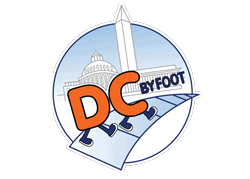
How to Use the Washington DC Metro

This post covers how to use the Metro subway in Washington, D.C., including tips on SmartTrip Cards, tourist passes, and how to navigate the public transport system.
While the DC Metro is great for getting you around the city, it can't get you around the National Mall. Let DC by Foot be your guide on one of our pay-what-you-like tours .
- Paying for Trips
- DC Metro Rail Map, Lines, and Stations
- How to Ride the DC Metro
- Other Travel Options
- Tips from Locals and Travelers
- Things to Do in DC
- Tourist Passes
PAYING FOR TRIPS
There are a few ways you can pay for your trips on the metro.
The information below will tell you about each.
SmarTrip Cards
You will need a SmarTrip card to enter and exit the DC Metro system.
A SmarTrip card is required for each rider aged 5 and older. Cards cannot be shared so each rider needs their own.
Note that up to two children under age five may travel free with each fare-paying adult.
SmarTrip cards with fare loaded on them can be used on the:
- DC Circulator bus
- ART (Arlington) bus
- CUE (Fairfax) bus
- DASH (Alexandria) bus
- Fairfax Connector bus
- RideOn (Montgomery County) bus
SmartTrip cards can be ordered online or you may buy a card at the station. They cost $15 each, with the price covering $2 for the card itself and a preloaded $13 credit.
They can be purchased from SmartTrip card vending machines like the one below, found at every Metro station.
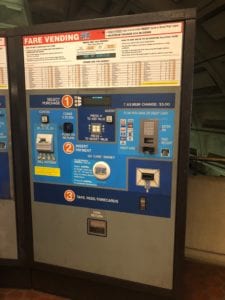
If you don't want to carry around a physical card, you can instead add a virtual card to your phone/mobile device using Apple Wallet or Google Pay.
There are also apps you can download onto your phone to do a number of things including purchasing cards, checking for trains, looking at maps, etc.
We recommend DCMetro Transit and MetroHero , however all of the apps over the same services. You only need too download one.
Pay-As-You-Go On The Metro
Another way to travel is by paying as you go.
There is no set fare for all trips as fares between stations depend on distance, the day, and the time.
Fares are based on the distance you'll be traveling between stations.
Each vending machine will show you what it costs to go from one station to another station in the system.
As far as times go, although the system does not have peak and off-peak hours, it does charge less at certain times.
From 5:00 am until 9:30 pm on weekdays the cost will land somewhere between $2 and $6.
After 9:30 pm on weekdays and over weekends, there will be a flat rate of $2.
Important Note: You can only use the same debit/card three times in one day before the machines will stop taking it. Metro machines do accept bills and coins though so you can always top things up that way.
1-Day and 3-Day Passes
If you don't want to worry about loading your card throughout the day, you can purchase a 1-day pass for $13/person or a 3-day pass for $28/person.
There are no travel restrictions, which means that you could use this pass anytime and without any additional charges.
While this may seem like a great deal, you'll want to do the math on how much you'll be traveling. The farther out your hotel or accommodations are, the better off this deal will be.
Passes will only work on Metrorail and Metrobus travel - passes are not accepted on regional buses, including the popular DC Circulator.
For most people, a 1 or 3-day pass really only makes sense if you plan on making more than 2 longer distance round trips per day.
Keep in mind that all Metrorail trips are a flat $2 fare on Saturdays and Sundays, so if you are mostly using Metro on a weekend, a pass is usually not the best deal. You are better off paying as you go.
If you're moving to DC or going to be spending a while in DC, there are 7-day pass and monthly commuter pass options.
These packages are specifically tailored to you and will give you unlimited rides for a set price. To learn more, click here .

DC METRO RAIL MAP, LINES, AND STATIONS
Metro stations are dotted throughout the city some stations have multiple entrances/exits.
You can locate them easily by looking for the tall brown post with the large letter M at the top.
The name of the station will be written on the side and the color of the lines that service that station will be encircled at the top of the post.

The Metro Lines
There are six lines, each represented by a different color.
- Red: serves the northern part of the city. The main stations are Union Station, Metro Center, Chinatown, and Dupont Circle.
- Blue : runs west-east through the city and then south. The main stations are Capitol South, Smithsonian, McPherson Square (White House), Arlington National Cemetery, and National Airport.
- Silver : runs west-east through the city. You can take this line all the way to Dulles Airport .
- Orange : runs east-west through the city. The orange/silver/blue lines follow the same tracks inside downtown. You will only need to pay attention to which train you're on if you're leaving the central area of the city.
- Green : runs north-south. Take the Green line to get to Navy-Yard/Nats Park Baseball Stadium.
- Yellow : runs north-south. The yellow line shares a track with Green for most of downtown. Both lines visit L'Enfant Plaza but Yellow continues south into Virginia to the Pentagon , National Airport , and King Street for Old Town Alexandria .
Washington DC Metro Map
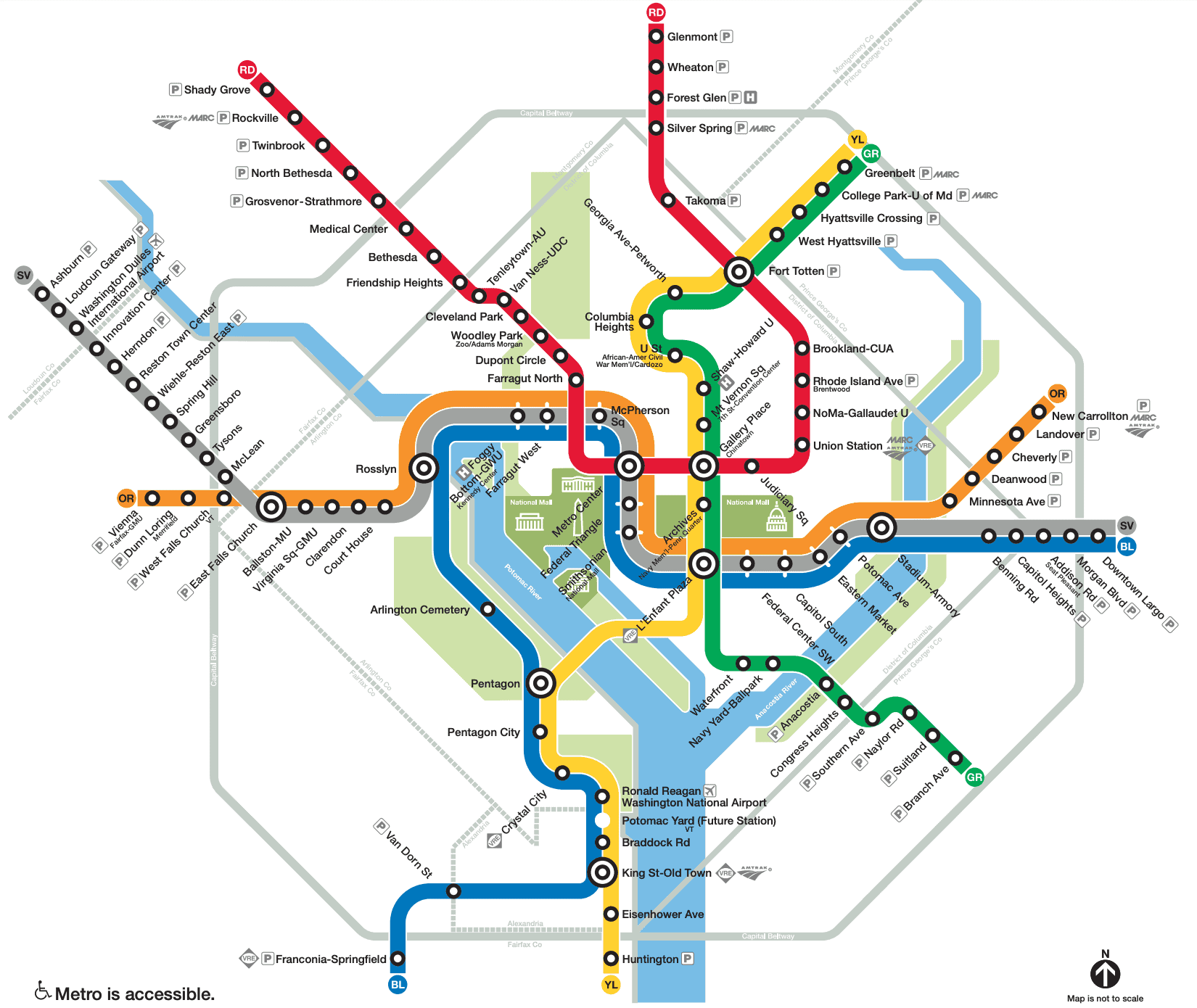
HOW TO RIDE THE DC METRO
The D.C. Metro system is a reliable and safe way to get around the nation's capital city.
Below is information that will help you plan and make your trip.
DC Metro Hours of Operation
In the table below, you'll find Metro's normal operating hours.
Please note that the schedules can be different on holidays.
You can find a full Metro schedule here .
Savings With the SmarTrip Card
Metrobus charges $2 a trip no matter the time or distance, but if you use a SmarTrip card you'll save .20 cents a ride.
Also note that if you use SmarTrip card, there's a two-hour window in which you can make as many bus rides as you want without being charged again.
And if you use the SmartTrip during a transfer from a train to a bus (and vice versa), Metro will credit back to you the fare you paid entering the system.
How Much To Put On Your SmarTrip Card
Metro’s Trip Planner will help you find the best way between destinations.
You enter the address or location of each end of your trip. For example, you might want to enter "White House" and "Capitol Hill" as the two locations you'd like to travel between.
The system also allows you to enter advanced options such as the time, date, the distance you're willing to walk, and more.
It then provides you with a few itineraries to choose from. Each itinerary includes the length of the trip, walking and riding directions, and the cost of the trip.
Note that if you parked at a Metro parking lot, you can also use your SmartTrip card to pay for that. You may want to figure that into your calculations.
How To Use Your SmarTrip Card
If you're riding a bus, you'll tap your card on the bus farebox near the driver as you enter.
For a metro ride, look for a fare gate inside a station with a green light on it. Those are the gates that are in use.
They will have a circular target on top where you'll touch your SmarTrip card. This opens the gate and allows you to go further into the station.
Note that at the end of your trip, you also have to tap the fare gate on the way out of the station. Don't forget to tap out or it will charge you extra !
When exiting, if you take a look at the small digital display on the fare gate. It will tell you how much money you still have left on your card.
Getting To Your Platform
Depending on the station, you'll usually have to go to the lower level to get to the train platform.
If the platform is in the center, there will be an escalator in the center as well.
Once you are at the bottom, you can check the signs for which side of the platform you need to stand on to access your train.
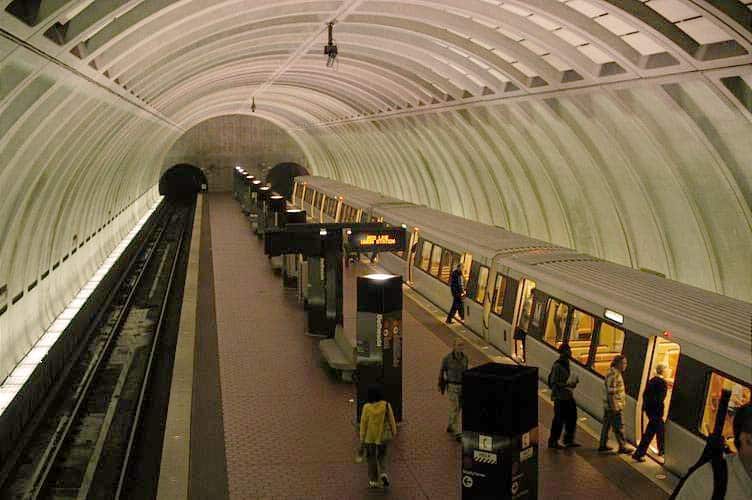
Center Platform
If the train tracks are in the center, and the platforms are on the sides, you'll need to take either or right or left escalator to get to that platform.
Again, check the signs to find which one you want to go down.
See below for more information on reading those signs correctly.
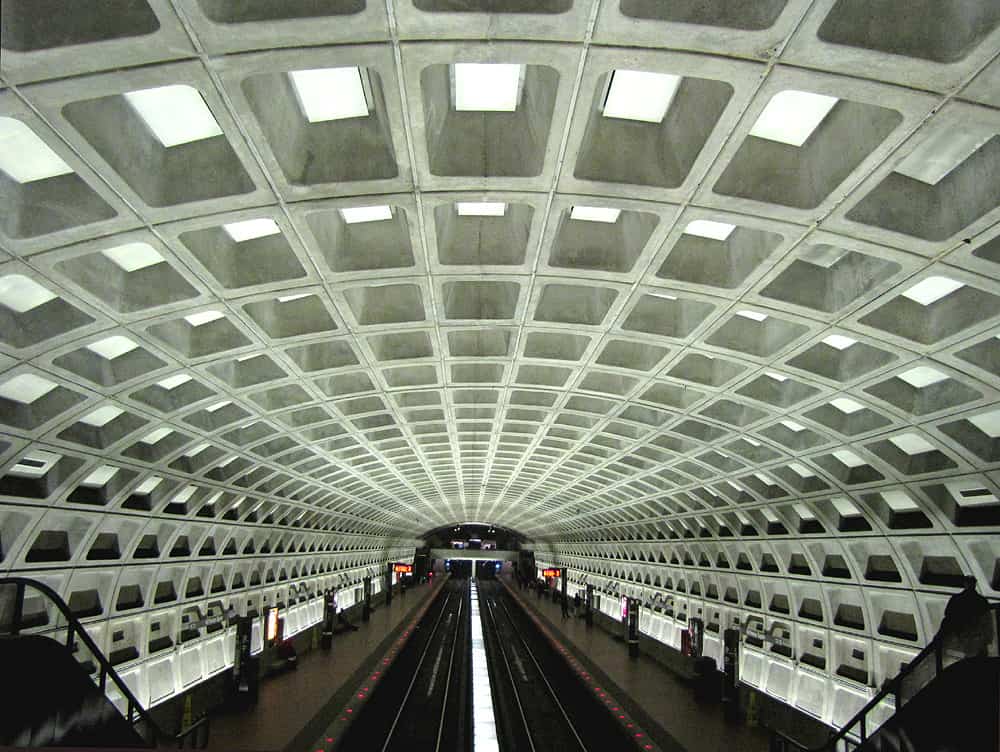
vs Center Tracks
Where to Stand To Catch the Correct Train
To decide which platform to stand on, you need to look for the name of the end-of-line.
There are maps in the stations to help you figure out the end of the line closest to your stop.
Then, find the platform that lists the corresponding final stop and head to it.
For stations with platforms on the sides, signs are usually listed at the top of the escalators so you know which side to go down to.
For stations with center platforms, you'll find signs at the bottom of the escalator.
Trains will also arrive with the end-of-the line station it's heading towards listed electronically on the front of it as well.
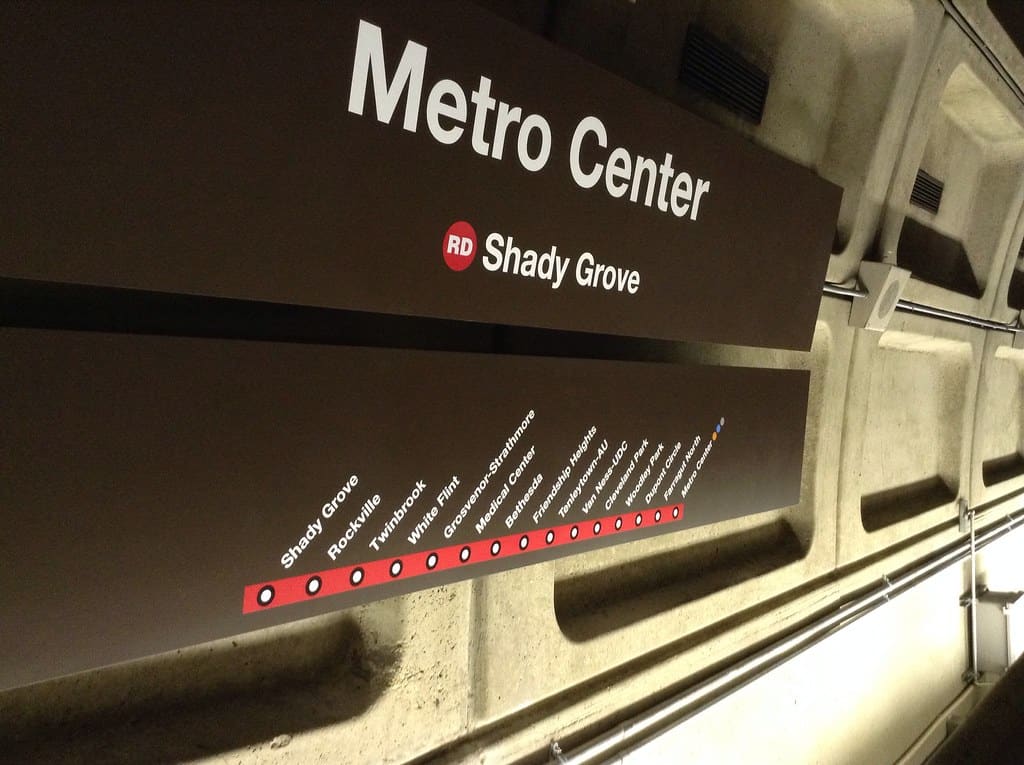
For example, as the picture above shows, the end-of-line for that half of the red line is Shady Grove.
You may want to get off at the Rockville stop, but you'll still need to know the name of last stop to ensure you're heading in the correct direction on that line.
If you were to get on the Red Line train to Glenmont instead of Shady Grove, you'd be going in the wrong direction and wouldn't find your stop along the way.
Trust us, it'll make sense once you're in the system!
Note: Sometimes trains don't go all the way to the end of the line but they will announce their last station stop.
As long as you're going in the right direction, and your stop is before that particular station, you'll be fine!
Reading the Signs On the Platform
When on the platform, signs will list the next three or four trains arriving.
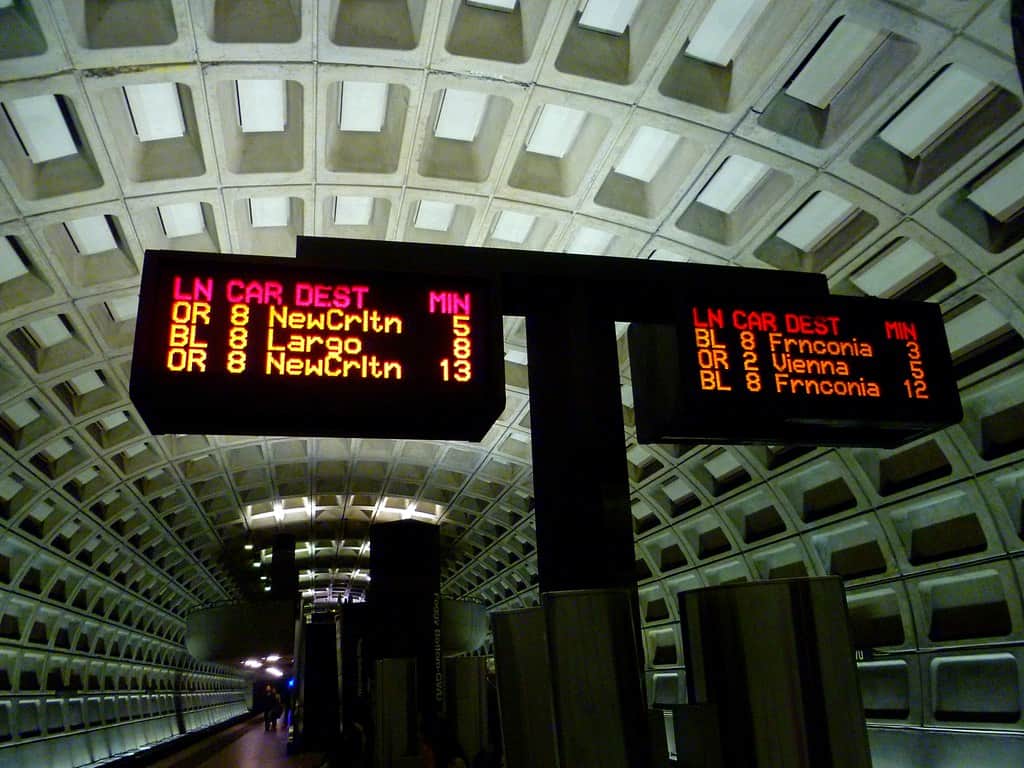
The information tells you four things:
- LN (Line) - which color line that train is on.
This matters if there are multiple colors of lines running through a station.
For example, Arlington National Cemetery is only on the Blue Line, but you may see Orange Line trains coming through on the same tracks. You'll want to be sure you are getting on a Blue Line train.
- CAR - how many cars are on that particular train.
If you stand at the very end of the platform, a shorter 6-car train may stop a distance from you. You'll then have to run to it to get on before the doors close.
Tip: If you check the platform's floor, there are sometimes decals to show you where those shorter 6-car trains end.
- DEST (Destination) - the last stop for this particular train.
Check this to make sure you're going in the right direction and on the correct line.
- MIN (Minutes) - how long until the train arrives.
During peak hours trains will come more frequently and in the evening they will come less often.
Keep this in mind if you're staying out late, as you might have to wait up to 20 minutes for the next train.
Getting on Your Train and Finding Your Stop
When a train is approaching, the circular lights at the edge of the platform will flash letting you know the train will be arriving soon.
Go up to the door and stand to the side. This lets people departing the train get off easily. Once they are off, you can more easily enter the train.
Once you are on the train, pay attention to the stops.
There are maps in each car and you'll be able to count out how many stops there are until you need to get off.
Note that some older trains won't electronically list the next stop in the route inside the car like the newer cars will.
And although train operators will announce stops it can sometimes be difficult to hear.
However, you can see which station you're arriving at as the train pulls in because the name of the station will be on the wall outside.
Getting to and From the Airport
DCA (Reagan National) and IAD (Dulles) airports are accessible by Metro though you may need to walk a bit to reach your terminal.
Our blogs posts below will tell you more about that.
- DCA National Airport
- Dulles (IAD) Airport
While the BWI (Baltimore Washington) Airport is no longer accessible directly by metro, click here to see our blog post about getting to and from BWI.
OTHER TRAVEL OPTIONS
If you're running late or worried about being stranded thanks to a Metro breakdown, don't fret. Trains are only one piece of the complex transit system of Washington, DC.
Buses serve even more territory than trains and they are cheap, clean (mainly), and frequent. Most are operated by Metro, though the Circulator routes are operated by the DC Department of Transportation.
With that said, your SmarTrip card works on all Metrobuses. Of course, you can always opt for ride-hailing services like Uber or Lyft or Cabs.
Hop On Hop Off Buses
The Metro is a great way to get around the city, but as visitors, it may not get you everywhere you need to go.
For example, in the entire 5 square miles of the National Mall, there is only one Metro Station. And there is no station on the Tidal Basin.
Hop-On-Hop-Off buses can come in handy in this case.
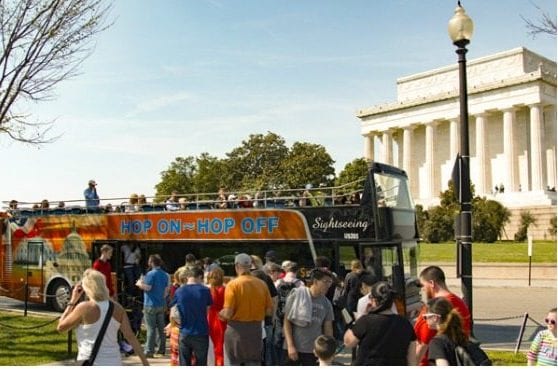
There are many bus companies and ticketing options. Read our post on choosing the best one for you.
They all have stops at the main sites around the city such as the Lincoln Memorial , WWII Memorial , Jefferson Memorial , and the US Capitol Building . These four sites are at least a 15-minute walk, if not more, from a Metro station.
Most Hop On Hop Off buses are included for free with the purchase of most tourist passes.
And don't forget our walking tours!
All of our tours start and end within walking distance of a Metro station. And our guides can make sure you know the best way to get to and from any place you want to see in the most direct route.
TIPS FROM LOCALS AND TRAVELERS
While we do our best to provide all the information you'll need to ride the DC Metro, sometimes you need answers to specific questions related to your personal experience.
Free Tours by Foot has a Washington, DC Travel Trips group on Facebook with over 55,000 members. It's a great place to post a question you'd like an answer to.
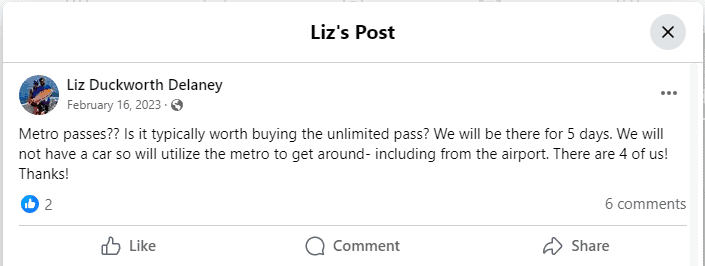
Here are a few other examples of interesting and helpful tips and tricks provided by staff and travelers, ones that will make things easier for you and your fellow riders.
- Don't stand on the left side of an escalator! The motto is: stand on the right, walk on the left. Some locals like to run up the steps of the escalator, so they are likely to be irritated (and vocal) if you're blocking the left side.
- Stand to the side of a bus or train door until everyone gets off. Standing smack in the middle of the door where people will get off the train is the quickest way to signal that you are a tourist. It's also a good way to get knocked around by all the bodies departing the train.
- Don't push your stroller through train doors to hold them open so you or others can get on. Doors have closed with children on one side and parents on the other. If the doors are closing, it's best to wait for the next train.
- If you have wheels, use the metro elevator. This means strollers, bikes, and wheelchairs. You may not want to wait for the elevator but trust us, the escalators are not made for anything with wheels. It's dangerous for all. Note also that all stations have elevators, though it's best to leave them for those who need them.
- Stand back from the side of the track. Yes, it's fun to see the train light coming through the darkness of a tunnel, and people are anxious about quickly getting on the train but it's dangerous to get too close. You could get jostled and fall onto the track, or your stroller could roll onto the trains due to the strong wind that comes through the station as the train arrives.
- Give up your seat to those who need them. If you see a pregnant person standing on the bus or metro...give her your seat. If you see someone leaning on crutches...give him your seat. If you see an octogenarian struggling against the forces of inertia and gravity...give up your seat!
- On the weekends, transferring to another Metro train isn't always the best option. Weekends are for track work, and that often means delays. Instead of transferring, see if there's a stop on the line you're already traveling on that's within striking distance of your destination. For example, if you're heading to the National Mall on the Red Line, skip the transfer over to the Blue/Orange/Silver lines by getting off at Metro Center. Sure, the Smithsonian Metro stop is smack in the middle of the Mall, but by the time you make the transfer, wait for a train, and then get back up to the surface, you could have already walked down from Metro Center.
- Check the time of the last train! If you're out late, be sure you remember to check when the trains stop running so you're not waiting on the platform for a train that won't come.
- Load before you go. If you're in town for a busy event, like the Fourth of July, a sporting event, or an inauguration, go ahead and load up the SmarTrip card with enough for the return trip as well. It'll save you from waiting in a massive line after the event.
RELEVANT POSTS
- Which DC Bus Tour is Best?
- How to Use the DC Circulator Bus
- Washington, DC Walking Tours
- Things to do in Washington, DC
- Private Washington, DC Tours
Choose a Destination... I want them all PLUS general travel tips. Amsterdam Berlin Boston Charleston Chicago Dubai Lisbon London Los Angeles Miami Nashville New York City New Orleans Paris Philadelphia Prague Rome San Francisco Washington DC
About The Author

Canden Arciniega
North america, united kingdom & ireland, middle east & india, asia & oceania.

Driving Time Calculator
Driving time between two cities.
Travelmath helps you find the driving time based on actual directions for your road trip. You can find out how long it will take to drive between any two cities, airports, states, countries, or zip codes. This can also help you plan the best route to travel to your destination. Compare the results with the flight time calculator to see how much longer it might take to drive the distance instead of flying. You can also print out pages with a travel map.
You may want to search for the driving distance instead. Or if you're thinking about flying, make sure you compare flight times between airports. For a long road trip, check the cost calculator to see if it's within your budget.
Home · About · Terms · Privacy


Amtrak NYC to DC: Why Taking the Train is the Best Way to Go
U nlock the advantages of traveling by train from the bustling Big Apple to the nation’s capital Washington DC with Amtrak. Say goodbye to airport security lines and traffic congestion as you embark on a relaxing journey from New York’s new Moynihan Train Hall.
With frequent departures, a generous baggage policy and the ability to move around during the under four-hour trip, Amtrak offers flexibility and convenience. Sit back and enjoy the ever-changing scenery while enjoying the onboard amenities that make your trip comfortable and enjoyable.
Amtrak Advantages: Travel Time
Anyone who has ever tried to drive out of New York City on a summer weekend, holiday or random gridlock alert day knows that the soul-crushing traffic can put a damper on the trip.
A journey from New York City to Washington DC by car can take anywhere from four to seven hours.
There are two Amtrak options:
- Amtrak Acela takes 2 hours and 46 (to 54) minutes. It stops at Newark Penn Station; Metropark, NJ; Philadelphia, Wilmington and Baltimore Penn Station, and the train can speed along at 150 miles an hour in some spots.
- Northeast Regional takes three hours and 20-40 minutes. It makes all of the stops the Acela makes, plus stops at the Newark and Baltimore airports, and it travels at slower speeds.
You can save almost an hour on the high-speed train, and up to four hours of hair-tearing hysteria by taking the train rather than your car.
Plus, the Acela has a First Class option, with free meals and drinks served to you at your seat. Philadelphia celebrity chef Stephen Starr curated the menu. The food in the Acela cafe car also has more interesting options than the cafe car on the Northeast Regional.
Read More: 15 Fun Things to Do in Alexandria VA: More Than Just a DC ‘Burb
Price: Amtrak vs Car
On a recent summer weekend, we paid about $40 for our roundtrip Amtrak tickets, bought well in advance. Had we waited to buy our tickets at the last minute, or planned to travel during the holidays, it would have been far more expensive.
When we realized we could take a morning train, getting us into Washington DC much earlier in the day than our ticketed departure, we learned that we would have to pay the difference in price. The morning train would have cost us more than five times the price we originally paid.
Driving to DC, the tolls can be $40, depending on route. And the gas? Let’s say you have a car that gets 25 miles per gallon. Gas will cost about $30 for the trip.
This is, of course, just one way, so you’ll spend another $70 to get back to NYC from Washington DC. But if 2 of you are in the car, the price per person drops. And three or four along for the ride? Even less.
But you have to weigh your sanity versus potential road rage. You do you.
Comfort in Coach
This is not your average airplace seat! Even in coach class on the slower Northeast Regional trains, there is plenty of legroom. You can put your bags up above, or in luggage areas at the end of cars.
Business class seats have the advantage of being assigned, so you don’t have to worry about dragging your suitcases through the train, looking for an available seat.
There is something weird with Amtrak train seats: If you have an aisle seat and don’t know the person sitting next to you, you have to run a cord across their seat to reach the power outlets.
And the free wifi isn’t really strong enough to do work on the train.
Quiet Car vs Other Seats on Amtrak Train
Now that my children are out of the house, I am a fan of the quiet car on Amtrak. Phone calls aren’t allowed and you have to use headphones if you use electronic devices, with the volume turned low.
But don’t take the quiet car with young children. Although you are allowed to talk in the quiet car, no one appreciates a loud child here. We once took this car because there were no other seats on the train. We were glared at until Philadelphia, when we escaped to the boisterous regular car.
Amtrak Pet and Baggage Policies
If you are bringing a dog, you might have to drive. Amtrak charges $26 for a dog, and it has to weigh under 20 pounds. My Labrador Retriever has plumped up to 70 pounds, so she is banned from the train, even though she works as a comfort dog. [Therapy dogs of any size are allowed].
Driving can also be the perfect option if you are schlepping a lot of stuff. Amtrak allows you to bring two pieces of luggage, and charges for oversized items like bicycles. On the Northeast Corridor, it costs $20 to bring a bicycle.
Though when I brought my daughter a folding bike, I didn’t have to pay extra.
Moynihan Train Hall, New York City
One of the best things about taking Amtrak anywhere from NYC is the new Moynihan Train Hall.
This glorious transformation of the historic Farley Post Office has transformed the former Amtrak area in Penn Station, which is across the street, to one of beauty and wonder. You also have access to great food.
If you take the subway to Moynihan Train Hall, the walk from the filth of the MTA to the shiny new Amtrak station is like the change from black and white to color in the Wizard of Oz . Light streams in from above, brass gleams and the air is – or at least seems – fresher.
Moynihan Food Hall
The centerpiece of Moynihan Food Hall, the Bar at Moynihan, has lots of local craft beer on tap and classic cocktails. Sit at the wood bar while you wait for an evening train.
The food hall has easy to eat or carry out food, like sushi, chopped salad, pizza and burgers. Alidoro makes Italian sandwiches that travel well and Naya has Mediterranean inspired bowls, wraps and salads. A ramen shop is coming, but ramen is best slurped up before the train.
If you are visiting someone – say, your daughter – in Washington DC, and you’ve forgotten to bring her bagels, you can pick some up at H & H, along with a few cupcakes at Magnolia or chocolates at Maison du Chocolat.
Exclusive Access: Metropolitan Lounge
If you have treated yourself to an Acela train ticket, or you have elite Amtrak status, you get access to Metropolitan Lounge. Business class passengers can also buy a day pass to the lounge.
This expansive sanctuary has lots of clean, comfortable places to sit, and free (non-alcoholic) drinks and food. There is also a bar, but you have to pay for drinks.
Even if you don’t have access to the Metropolitan Lounge, The Amtrak waiting area at Moynihan, for ticketed passengers only, has very clean bathrooms and power outlets at every seat.
Getting to Your Amtrak Train
One issue the fabulous Moynihan Train Hall hasn’t addressed is the chaos that ensues when a train track is announced. There is only one escalator to the track and it’s a bloodsport to get on the line before it resembles a Black Friday queue.
But there are 2 semi-secret ways to avoid the line.
- When the train is announced, go to the elevator and take it to the track. Very few people do this.
- Passengers in the Metropolitan Lounge get an early announcement of the track number and can take the elevator before the line even forms.
Union Station Washington DC
When you walk into Union Station in Washington DC, you are in a beautiful historic train station. Unfortunately, the Amtrak area, while not as grim as Penn Station in Manhattan was, is still pretty dismal.
There is an Acela Lounge at Union Station. For ‘regular’ passengers, there is a dim seating area and the usual scrum when the track is announced. One advantage here over Moynihan Train Hall is that the trains are on the same level as the waiting area. No crowded escalators, stairs or elevators to navigate.
Picking a Train
Some trains originate in NYC, which means finding a seat on the train going to DC is pretty easy. It also means that the train is cleaner. If the Amtrak is coming from Boston, people might be getting off in NYC. But they are not taking their garbage with them and no one is cleaning the train.
On our recent Amtrak ride, someone did come around collecting trash, but the guy next to me left a mess in his seat and no one addressed that.
And don’t even get me started on the bathrooms. I can’t imagine what the bathrooms look like on the trains going all the way to Miami or Chicago.
Before Going to DC, Ask Yourself…
A lot of considerations go into a trip from New York City to Washington DC.
Q: Do you want to see the cherry blossoms ?
A: Go mid-March to mid-April
Q: Do you want to take long walks around the National Mall?
A: Go late September to November or March to May
Q: Do you want to avoid tourists?
A: Don’t go to Washington DC
What to Do in Washington DC
Tour the us capitol.
The US Capitol visitors center has an interactive gallery. There are also tours of the Capitol building, including the Crypt, the Rotunda and National Statuary Hall. Tours and exhibits are all free.
The rest of the National Mall includes the Lincoln Memorial and the Washington Monument, the White House and Smithsonian museums. Again, everything is free.
Stop and See the Flowers
See the green side of Washington DC at Tregaron Conservancy. It has walking trails, gardens, fields, meadows and a lily pond. The conservancy, between the Woodley Park and Cleveland Park, is free. You can also see the free National Zoo, near the conservancy
Read here for more things to do in and around Washington DC.
The post Amtrak NYC to DC: Why Taking the Train is the Best Way to Go appeared first on She Buys Travel .
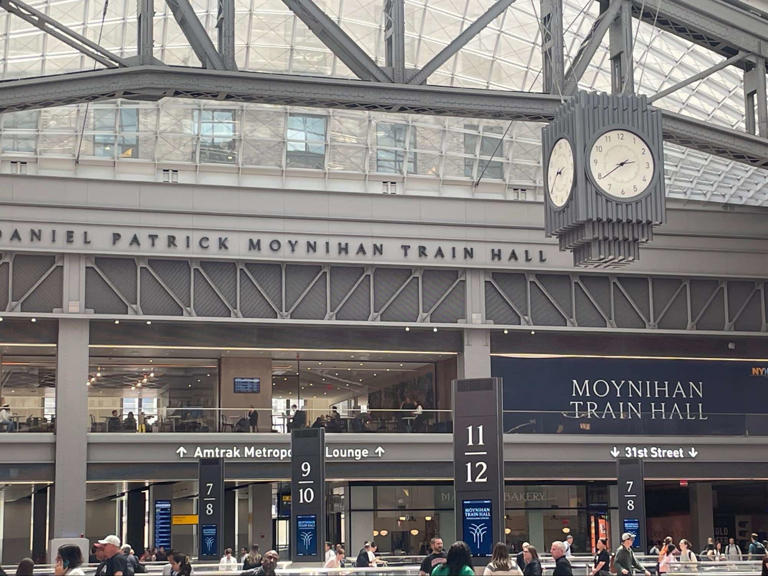
Read the e-Newspaper
Read the e-newspaper subscribers only.
- Subscribe to the Tampa Bay Times
- Sign up for the DayStarter morning newsletter
- Donate to the Tampa Bay Times
Keep up with Tampa Bay’s top headlines
Subscribe to our free DayStarter newsletter
You’re all signed up!
Want more of our free, weekly newsletters in your inbox? Let’s get started.
ONLY AVAILABLE FOR SUBSCRIBERS
The Tampa Bay Times e-Newspaper is a digital replica of the printed paper seven days a week that is available to read on desktop, mobile, and our app for subscribers only. To enjoy the e-Newspaper every day, please subscribe.

IMAGES
VIDEO
COMMENTS
Plan your trip with WMATA's online tool, providing efficient routes and schedules for your journey.
Metrorail Schedule: Hours: Sunday 1/1/2024: New Year's Day: Sunday Holiday: 7am - midnight: Monday ... *Exact closing time has not yet been determined for New Year's Eve, and will be updated closer to the actual date ... TRAVEL INFORMATION 202.637.7000. TTY 202.962.2033. TRANSIT POLICE 202.962.2121. TEXT: MYMTPD (696873)
Metro fares are calculated by how many stops you travel and vary during peak and off-peak hours. During peak hours, most fares range from $2.25 to $6 per trip. During off-peak hours, fares typically range from $1.85 to $3.85. Metro riders must pay via SmarTrip card or the SmarTrip app on iPhone and Apple Watch .
Tips. The most crowded times are 7:45 a.m. to 8:45 a.m. and 4:45 p.m. to 5:45 p.m. The busiest days are Tuesdays, Wednesdays, and Thursdays. If you have flexibility in your schedule, consider riding Metro during the reduced fare hours: after 9:30 a.m., before 3 p.m., and after 7 p.m. on weekdays.
The DC metro is the busiest transportation network, with over 355,000 weekday entries recorded by 2023, according to WMATA. The metro network consists of six color-coded lines: Orange Line, Red Line, Silver Line, Blue Line, Green Line, and Yellow Line. There are a total of 98 stations indicated by small circles on the map, and 128 miles of track.
Washington DC's Metro system is a great way to get to hundreds of popular locations and attractions in and around Washington DC. Metro's six lines and 91 stations are located in Washington DC and neighboring Virginia and Maryland. With over 700,000 trips every weekday, the rail system provides easy access to popular attractions including the ...
Introducing the ultimate travel app for Washington, D.C.! Say goodbye to waiting for buses or trains with our real-time tracking feature that shows you exactly where your ride is and when it will arrive. • Our app offers up to five different route options to your destination, so you can choose the fastest or most convenient route for your trip.
Fares. Metro fares vary by time of day, trip distance (entry/exit stations), and type of payment. The prices indicated assume that the rider us using a SmarTrip card . Peak fares (weekdays 5:00am - 9:30am, and 3pm-7pm; weekends midnight - closing): $2.10 - $5.75. Off-Peak fares (all other times): $1.70 - $3.50.
Here's where it gets slightly trickier: the fare for each ride will depend on how far and when you're riding. Fares will be more expensive at rush hour, or peak times, between 5 am and 9:30 am in the morning and between 3 pm and 7 pm in the afternoon. Peak fares run anywhere between $2.25 and $6, while off peak fares won't net you more ...
About this app. DC Transit uses the Washington Metropolitan Area Transit Authority (WMATA)'s real time data to get you DC Metro and Bus arrival times. Trip Planner available (Plan your trip around Washington DC & Baltimore. WMATA, DC Circulator, Arlington Transit (ART), DC Streetcar, PG County, Maryland Transit, Fairfax CUE and UMD Shuttle ...
How to I travel from National Harbor to Washington DC? National Harbor is not directly metro accessible, but there is a Metrobus line, NH1 which provides access to Branch Avenue, a station on metro's green line. Instead of bus, you can also drive to Branch Avenue station (about 12 minutes with light traffic) or Huntington station on the yellow ...
Get real-time train performance data on MetroPulse. EXPLORE NOW. Schedules & Maps. Trip Planner ... Metro's trip planning tools provide instant itineraries and service alerts for trips on Metrorail and Metrobus. In This Section. Trip Planner. Trip Planner. Directions, times, & fares ... TRAVEL INFORMATION 202.637.7000. TTY 202.962.2033. TRANSIT ...
Take our apps with you, just search Mapway on App Store. Washington DC Metro VIP available as an in-app subscription: $1.99 monthly or $4.99 annually, or as a one-off purchase of $12.99. Prices may vary by location. Cancel at any time, for any reason. Payment will be charged to your iTunes Account at confirmation of purchase.
A map of the travel time from Metro Center to each Metrorail station, based on Metro's online trip planner. Image by the author. Like most American rail transit systems, Metrorail is arranged in a way that sends most trips toward a cluster of downtown stations where the lines converge.
1-Day and 3-Day Passes. If you don't want to worry about loading your card throughout the day, you can purchase a 1-day pass for $13/person or a 3-day pass for $28/person. There are no travel restrictions, which means that you could use this pass anytime and without any additional charges.
Follow the signs to your platform and wait for your train to arrive. Several trains run on the same line at major stops (such as Rosslyn), so make sure you board the right train. Signs at the platform indicate which train it is. Board the train and enjoy the ride. Just listen for your stop to be announced.
Travelmath helps you find the driving time based on actual directions for your road trip. You can find out how long it will take to drive between any two cities, airports, states, countries, or zip codes. This can also help you plan the best route to travel to your destination. Compare the results with the flight time calculator to see how much ...
View real-time train locations. ... We want your trip to be safe, convenient, and easy on Metro, so we developed travel tips to help you plan for major events around the area. Read more. Metro + Capital Bikeshare. We've teamed up with Capital Bikeshare to offer free bike rides to eligible customers on our region's bike share system. Add a ...
The DC Metro system consists of six lines serving Washington DC, Virginia, and Maryland. For more information about the map above, see our page on the DC Metro Map. See individual stations for more information about directions, attractions, parking, and live "Next Train" predictions: (Learn more about the DC Metro Map) Red Line
Red Line Shady Grove - Silver Spring every 8 minutes until 9:30 p.m., then every 10 minutes until close.; Red Line Silver Spring - Glenmont every 16 minutes until 9:30 p.m., then every 20 minutes ...
Amtrak Advantages: Travel Time. Anyone who has ever tried to drive out of New York City on a summer weekend, holiday or random gridlock alert day knows that the soul-crushing traffic can put a ...
Metrorail provides safe, clean, reliable transit service for more than 600,000 customers a day throughout the Washington, DC area. The system is the second busiest in the United States, serving 98 stations in Virginia, Maryland, and the District of Columbia. The Metrorail system has six color-coded rail lines: Red, Orange, Silver, Blue, Yellow ...
Explore metro maps for different lines, stations, and zones. Plan your trip and find the best route with WMATA.
The Megabus Route M32 offers nine trips per day between Washington DC to Baltimore. The fastest bus makes the trip in one hour and 15 minutes. Buses offer Wi-Fi, outlets, and Megabus onboard entertainment. Megabus is also Green Certified, if you are looking for a more earth-friendly transportation option.
The Tampa Bay Times e-Newspaper is a digital replica of the printed paper seven days a week that is available to read on desktop, mobile, and our app for subscribers only. To enjoy the e-Newspaper ...
Metrorail. Fares vary by time of day, day of the week the trip is taken, and the distance traveled between the origin and destination stations ... Metrorail and Metrobus trips are free for DC students who attend public, private, charter, or parochial schools through the DC Kids Ride Free program; ... TRAVEL INFORMATION 202.637.7000. TTY 202.962 ...
Metro's customer service team is available to assist with your questions or travel needs from 7 a.m. until 8 p.m. Call us at Metro customer information at (202) 637-7000 [TTY 202-638-3780], chat or message us on Facebook Messenger, or contact us on X @metrorailinfo @metrobusinfo @wmata. Real-time bus and train arrivals are available on ...